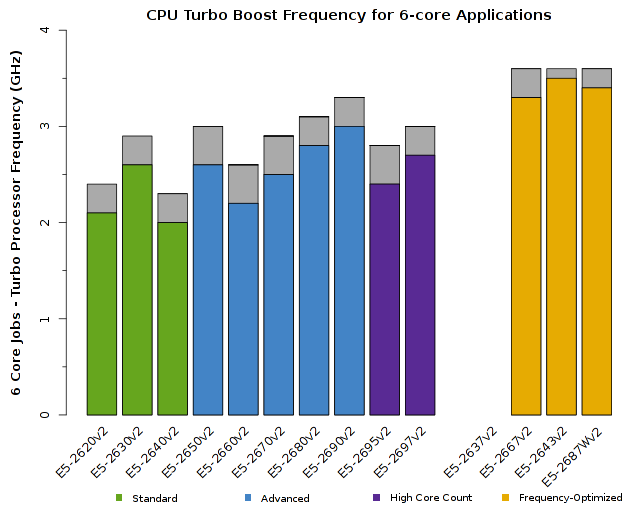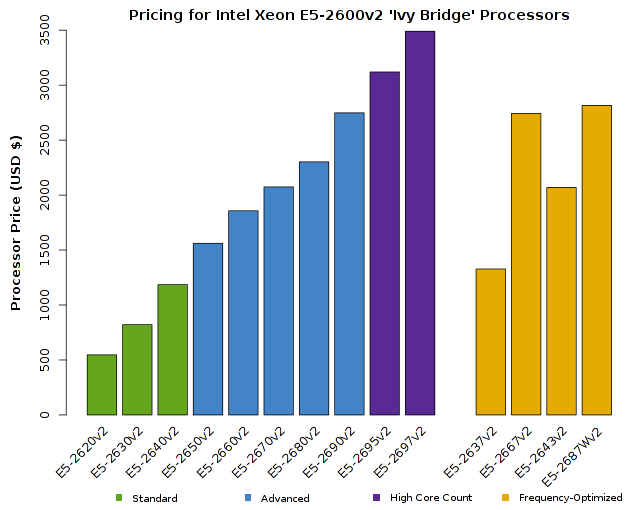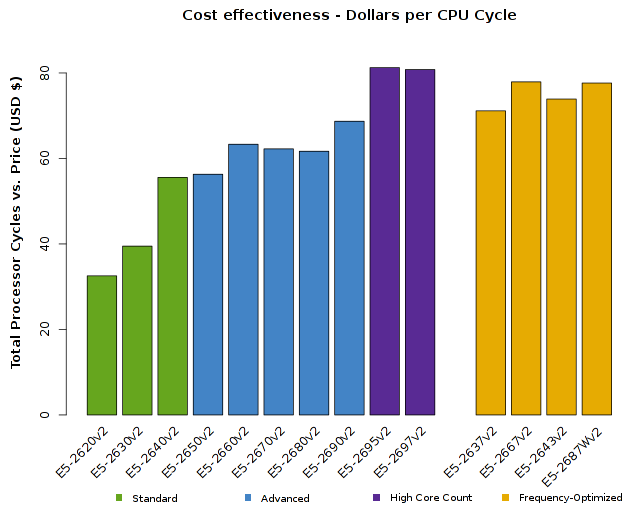This article provides in-depth discussion and analysis of the 22nm Xeon E5-2600v2 series processors (formerly codenamed “Ivy Bridge”). “Ivy Bridge” processors improve upon the previous 32nm “Sandy Bridge” microarchitecture and are available for sale as of September 10, 2013. For an introduction, read our blog post Intel Xeon E5-2600v2 “Ivy Bridge” Processor Review
Important changes available in E5-2600v2 “Ivy Bridge” include:
- Up to 12 processor cores per socket (with options for 4-, 6-, 8- and 10-cores)
- Support for DDR3 memory speeds up to 1866MHz
- Improved PCI-Express generation 3.0 support with improved compatibility and new features: atomics, x16 non-transparent bridge & quadrupled read buffers for P2P transfers
- AVX has been extended to support F16C (16-bit Floating-Point conversion instructions) to accelerate data conversion between 16-bit and 32-bit floating point formats
- Intel APIC Virtualization (APICv) provides increased virtualization performance
With a product this complex, it’s very difficult to cover every aspect of the design. Here, we concentrate primarily on the performance of the processors for HPC applications.
Intel Xeon E5-2600v2 Series Specifications
Intel Turbo Boost in Xeon E5-2600v2 series “Ivy Bridge” processors
Summary of features in Xeon E5-2600v2 “Ivy Bridge” processors
In addition to the capabilities mentioned at the top of this article, these processors include many of the successful features from earlier Xeon designs. The list below provides a summary of relevant technology features:
- Up to 12 processor cores per socket (with options for 4-, 6-, 8- and 10-cores)
- Support for Quad-channel ECC DDR3 memory speeds up to 1866MHz
- Direct PCI-Express (generation 3.0) connections between each CPU and peripheral devices such as network adapters, GPUs and coprocessors (40 PCI-E lanes per socket). Improved PCI-Express generation 3.0 support with improved compatibility and new features: atomics, x16 non-transparent bridge & quadrupled read buffers for P2P transfers
- Advanced Vector Extensions (AVX) accelerate floating point operations used in HPC & technical computing applications. This technology expands the math unit from 128-bits to 256-bits, effectively doubling throughput. AVX has been extended to support F16C (16-bit Floating-Point conversion instructions) to accelerate data conversion between 16-bit and 32-bit floating point formats
- Turbo Boost technology improves performance under peak loads by increasing processor clock speeds. With version 2.0, (introduced in “Sandy Bridge”) clock speeds are boosted more frequently, to higher speeds and for longer periods of time.
- Dual Quick Path Interconnect (QPI) links between processor sockets improve communication speeds for multi-threaded applications
- Intel Intelligent Power Technology reduces individual idling cores to near-zero power. Power gates adjust processors and memory to the lowest available power state to meet workload requirements without impacting performance.
- Intel Data Direct I/O Technology increases performance and reduces latency by allowing Intel ethernet controllers and adapters to talk directly with the processor cache
- Advanced Encryption Standard New Instructions (AES-NI) accelerate encryption and decryption for fast, affordable data protection and security
- 32-bit & 64-bit Intel Virtualization Technology (VT/VT-x) forDirected I/O (VT-d) and Connectivity (VT-c) deliver faster performance for core virtualization processes and provide built-in hardware support for I/O virtualization.
- Intel APIC Virtualization (APICv) provides increased virtualization performance
- Hyper-Threading technology allows two threads to “share” a processor core for improved resource usage. Although useful for some workloads, it is not recommended for HPC applications.



















